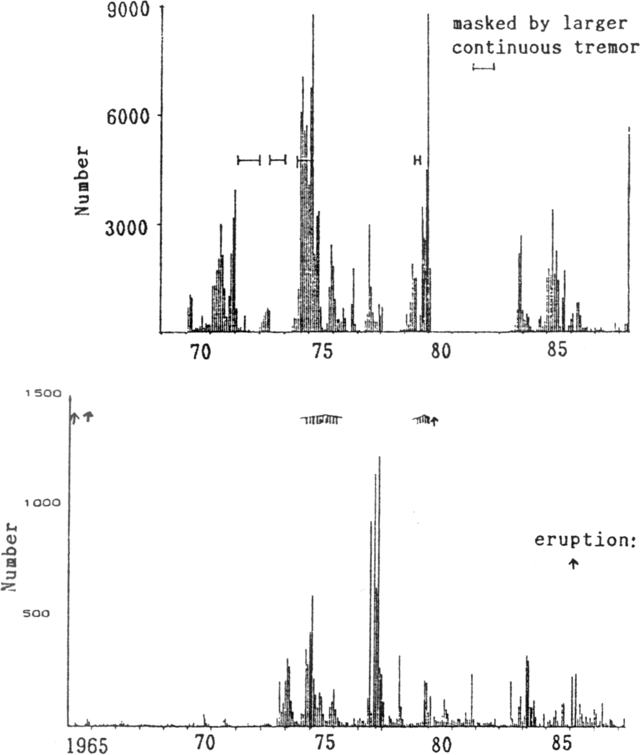Report on Asosan (Japan) — May 1988
Scientific Event Alert Network Bulletin, vol. 13, no. 5 (May 1988)
Managing Editor: Lindsay McClelland.
Asosan (Japan) Tremor stronger and more frequent; mud ejection
Please cite this report as:
Global Volcanism Program, 1988. Report on Asosan (Japan) (McClelland, L., ed.). Scientific Event Alert Network Bulletin, 13:5. Smithsonian Institution. https://doi.org/10.5479/si.GVP.SEAN198805-282110
Asosan
Japan
32.8849°N, 131.085°E; summit elev. 1592 m
All times are local (unless otherwise noted)
The number of tremor episodes recorded by a seismograph 0.8 km from [Crater 1] increased sharply to ~5,900 in May from the typical 100-500/month (figure 8). Activity declined slightly beginning 30 May to about 100 tremor episodes/day by 6 June. Background tremor was continuous and amplitudes in May were twice usual values (figure 10). The floor of Naka-dake's crater 1 had been covered by a pool of water that gradually dried up toward the end of May. Mud ejection about 10 m high from the crater bottom was observed during a field survey 26-27 May. Public access to the area around the crater was prohibited 25 May-6 June.
Geological Summary. The 24-km-wide Asosan caldera was formed during four major explosive eruptions from 300,000 to 90,000 years ago. These produced voluminous pyroclastic flows that covered much of Kyushu. The last of these, the Aso-4 eruption, produced more than 600 km3 of airfall tephra and pyroclastic-flow deposits. A group of 17 central cones was constructed in the middle of the caldera, one of which, Nakadake, is one of Japan's most active volcanoes. It was the location of Japan's first documented historical eruption in 553 CE. The Nakadake complex has remained active throughout the Holocene. Several other cones have been active during the Holocene, including the Kometsuka scoria cone as recently as about 210 CE. Historical eruptions have largely consisted of basaltic to basaltic-andesite ash emission with periodic strombolian and phreatomagmatic activity. The summit crater of Nakadake is accessible by toll road and cable car, and is one of Kyushu's most popular tourist destinations.
Information Contacts: JMA.


